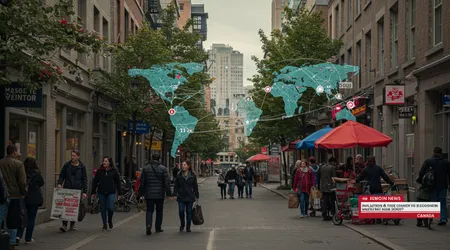Inflation & Trade Risk to Economy: Could Canadian Banks Tighten Lending Soon?

Inflation & Trade Risk to Economy loom large over Canada in 2025, casting shadows on financial stability.
As global trade tensions escalate, particularly with U.S. tariffs, and inflation hovers above the Bank of Canada’s 2% target, the nation’s economic outlook grows murky.
Canadian banks, the backbone of the financial system, face mounting pressure. Will they tighten lending to shield against potential defaults?
This question pulses through boardrooms and households alike. Recent data, like the Bank of Canada’s April 2025 survey showing 40% of firms bracing for lower sales due to tariffs, underscores the stakes.
This article dives into how Inflation & Trade Risk to Economy are reshaping banking strategies, offering practical insights and real-world examples to navigate this storm.
The interplay of inflation and trade uncertainty creates a complex challenge. Banks, wary of rising loan defaults, may curb lending, impacting consumers and businesses.
From small-town entrepreneurs to urban homeowners, the ripple effects could be profound. Yet, banks must balance caution with growth to avoid stifling the economy.
This piece explores the risks, dissects bank responses, and provides actionable takeaways. Why should Canadians care? Because the decisions banks make now could dictate financial realities for years to come.
The Perfect Storm: Inflation and Trade Tensions in 2025
Rising Inflation & Trade Risk to Economy threaten Canada’s economic stability. Inflation hit 1.7% in May 2025, but core measures exceed the Bank of Canada’s 2% target. U.S. tariffs, sparked by President Trump’s policies, add fuel to the fire.
Canadian exports, vital to GDP, face headwinds, with May 2025 trade data showing persistent lows despite CUSMA exemptions. Businesses, especially in manufacturing, are slashing sales forecasts, signaling caution.
This uncertainty breeds a cautious mindset. Firms hesitate to invest, and consumers tighten budgets, wary of job security. The Bank of Canada’s pause at 2.75% interest rates reflects this tension, balancing growth against inflationary pressures.
If tariffs persist, input costs could spike, further driving inflation. For banks, this means higher risks of loan defaults, especially in trade-exposed sectors.
Picture a small Alberta manufacturer, MapleTech, struggling to export machinery due to tariffs. Loan repayments falter as orders dry up.
++ AI Tax Credits & Clean Tech Incentives: How Businesses Can Leverage 2025 Savings
Banks, sensing this, may tighten credit, limiting MapleTech’s growth. This scenario, multiplied across industries, illustrates the broader economic squeeze. Inflation & Trade Risk to Economy aren’t abstract they hit real businesses hard.
The labor market, already strained at 7% unemployment in May 2025, faces further pressure. Trade-dependent regions like Ontario and Quebec are hit hardest.
Banks, monitoring these trends, may prioritize safer loans, sidelining riskier ventures. This shift could deepen economic divides, favoring large corporations over small businesses.

Canadian Banks: Navigating a Risky Landscape
Banks face a dilemma as Inflation & Trade Risk to Economy intensify. Loan loss provisions are rising, with four of the Big Six banks reserving over C$1 billion in Q2 2025.
Royal Bank of Canada (RBC), for instance, crafted a trade disruption scenario forecasting recession risks, including unemployment spikes and asset price drops. This conservative stance signals preparedness but also caution.
Tighter capital requirements, a legacy of Basel III, limit lending flexibility. Riskier borrowers face reduced credit, while safer firms benefit disproportionately.
Also read: Tax Toolkit 2025: New CPP, TFSA, HBP Limits and Capital Gains Deferral Strategies
Banks like BMO, with heavy commercial lending exposure, expect a 49% jump in provisions, reflecting economic unease. This shift could choke small businesses reliant on credit to weather trade disruptions.
Yet, banks aren’t helpless. Digital transformation, like CIBC’s new education portfolios, shows innovation in managing risk. By diversifying offerings, banks can offset losses.
Still, the specter of Inflation & Trade Risk to Economy demands vigilance, as loan defaults could strain balance sheets further.
Consider Jane, a Toronto restaurateur seeking a loan to expand. Her bank, citing trade war risks, demands stricter terms.
Jane’s dream stalls, a microcosm of broader lending caution. Banks must weigh such decisions carefully to avoid economic stagnation.
Sophisticated data analytics, adopted by banks like Scotiabank, help monitor risks in real-time. These tools allow precise lending decisions, balancing caution with opportunity.
However, over-reliance on conservative models could starve innovative startups, stifling Canada’s economic dynamism.
Read more: Canada Adjusts Steel & Aluminum Tariffs: What This Means for Your Wallet in 202
Impact on Consumers and Businesses
Inflation & Trade Risk to Economy hit consumers and businesses hardest. Households, already stretched by high debt, face rising costs.
The Bank of Canada notes 65% of firms expect cost increases from tariffs, with 40% planning price hikes. This squeezes family budgets, reducing loan affordability. Mortgage interest and food prices, though easing, remain pain points.
Businesses, especially exporters, are in a bind. Manufacturing firms, like those in Ontario’s auto sector, face tariff-driven cost spikes.
Reduced loan access compounds this, as banks grow risk-averse. The unemployment rate, hitting 7% in May 2025, signals job losses in trade-sensitive regions. Small businesses, the economy’s lifeblood, may struggle to survive.
Imagine a Vancouver retailer, Pacific Imports, reliant on U.S. goods. Tariffs inflate costs, and tighter bank lending limits inventory purchases. Sales drop, threatening closure.
This domino effect underscores how Inflation & Trade Risk to Economy can cascade through communities, urging banks to act prudently yet flexibly.
Consumers face a psychological toll, too. The Bank of Canada’s consumer survey shows growing job security fears, curbing spending.
This caution reduces loan demand, but also economic activity, creating a feedback loop. Banks must navigate this delicately to avoid deepening the slowdown.
Bank Strategies: Tightening or Adapting?
How are banks responding to Inflation & Trade Risk to Economy? Many are bolstering reserves, as seen in RBC’s Q2 2025 strategy.
Others, like TD Bank, face scrutiny as lending slows amid economic uncertainty. Yet, outright tightening isn’t universal. Some banks leverage digital tools to assess risk better, reducing defaults without slashing credit.
CIBC’s $227 billion in managed assets highlights diversification as a buffer. Mobile banking trends, with AI-driven risk models, help banks like Scotiabank target safer loans.
Still, if trade wars escalate, banks may have no choice but to tighten, risking economic slowdown. The Bank of Canada warns of reduced credit access amplifying downturns.
Balancing act is key. Banks could emulate global peers, like Chinese banks using digital platforms to spread risk across regions.
By adapting, Canadian banks can mitigate Inflation & Trade Risk to Economy without choking growth. Flexibility now could preserve stability later.
Some banks explore alternative revenue streams, like National Bank’s focus on wealth management. This diversification cushions against lending losses.
However, over-caution could alienate small businesses, pushing them toward riskier non-bank lenders, which could destabilize the financial system further.
The Broader Economic Picture
Inflation & Trade Risk to Economy ripple beyond banks. Canada’s GDP grew in Q1 2025, but contraction looms due to trade uncertainty.
The Canadian dollar’s strength against a weakening U.S. dollar offers some relief, but not enough. Global trade fragmentation, fueled by geopolitics, threatens long-term growth.
The Bank of Canada’s 2.75% rate hold signals caution, with economists predicting two more cuts in 2025. Yet, a Scotiabank report suggests a potential 300-basis-point hike if tariffs spike inflation.
This tug-of-war between growth and price stability complicates bank lending decisions. A recession, though not certain, remains a real risk.
Think of the economy as a ship navigating stormy seas. Banks are the crew, steering between inflation’s waves and trade’s rocks. Misjudge the course, and the ship falters.
Inflation & Trade Risk to Economy demand steady hands to avoid capsizing Canada’s financial future.
Global trends, like the ECB’s focus on scenario analysis, offer lessons. Canadian banks could adopt similar tools to stress-test portfolios against trade shocks.
Without such foresight, lending decisions may lag, exacerbating economic volatility.

Practical Insights for Canadians
Navigating Inflation & Trade Risk to Economy requires proactive steps. For consumers, prioritize debt management pay down high-interest loans before rates rise.
Businesses should diversify supply chains to mitigate tariff impacts, as seen with MapleTech’s pivot to Asian markets. Banks offer tools like CIBC’s education portfolios for long-term planning.
Household budgeting apps, leveraging AI, can track expenses amid rising costs. For entrepreneurs, explore government grants to offset trade losses.
Staying informed via Bank of Canada reports helps anticipate rate shifts. Inflation & Trade Risk to Economy demand resilience act now to secure your financial footing.
For businesses, renegotiating loan terms early can prevent default risks. Consumers should explore fixed-rate loans to hedge against potential rate hikes. Staying proactive, not reactive, is the key to thriving amid uncertainty.
| Metric | Q1 2025 | Q2 2025 (Projected) |
|---|---|---|
| Inflation Rate | 1.7% | 2.0%+ |
| Unemployment Rate | 6.9% | 7.0%+ |
| Loan Loss Provisions | C$1B+ (4 banks) | C$1.2B+ |
| Interest Rate | 2.75% | 2.5%–3.0% |
Conclusion: Preparing for an Uncertain Future
Inflation & Trade Risk to Economy are reshaping Canada’s financial landscape in 2025. Banks, caught between caution and growth, may tighten lending, impacting everyone.
From MapleTech’s export struggles to Jane’s stalled expansion, the stakes are personal. The Bank of Canada’s delicate balancing act holding rates at 2.75% while eyeing cuts reflects this tension.
Canadians must stay agile, leveraging tools like digital banking and diversified strategies to weather the storm.
The question isn’t just whether banks will tighten lending, but how we’ll adapt if they do. Are you ready for what’s next?
Action now can soften the blow. Businesses should explore new markets, while consumers tighten budgets and monitor economic signals.
Banks, as economic stewards, must innovate to balance risk and opportunity. The path ahead is uncertain, but resilience and foresight can steer Canada through.
Frequently Asked Questions
Will banks stop lending entirely due to trade risks?
No, banks won’t halt lending but may tighten criteria, prioritizing low-risk borrowers. Diversified strategies, like CIBC’s portfolios, help maintain credit flow.
How can consumers protect finances amid inflation?
Focus on reducing high-interest debt and using budgeting apps. Monitor Bank of Canada reports for rate changes to plan effectively.
